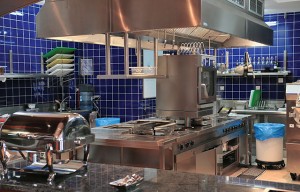 How many times have we experienced a wonderful meal only to be afflicted by food poisoning the next day? For most of us, the issue is resolved by the body’s natural reaction to purge it out. But we also know of people requiring hospital admission and treatment and in some cases, loss of life. There is an absence of global data on food poisoning cases but in the United States of America alone, the Centers for Disease Control and Prevention (CDC) recorded approximately 48 million people contracting foodborne illness with 128,000 being hospitalised and 3,000 losing their life in 2012.¹
How many times have we experienced a wonderful meal only to be afflicted by food poisoning the next day? For most of us, the issue is resolved by the body’s natural reaction to purge it out. But we also know of people requiring hospital admission and treatment and in some cases, loss of life. There is an absence of global data on food poisoning cases but in the United States of America alone, the Centers for Disease Control and Prevention (CDC) recorded approximately 48 million people contracting foodborne illness with 128,000 being hospitalised and 3,000 losing their life in 2012.¹
Food handling is a huge responsibility as many times incidences of foodborne illnesses would have been preventable if standards of safety and hygiene were properly maintained. What then do we mean by ‘food quality’? It means the quality characteristics in food that are deemed acceptable to consumers which comprises external factors such as appearance (colour, shape, size, gloss and consistency), texture of the food item and flavour as well as internal characteristics which takes the chemical, physical and microbial attributes into account.² This definition goes beyond the food served in front of us but includes food manufacturing as contamination can occur during the manufacturing process or attributed to the sanitation of the processing environment. Under food quality, product traceability and labeling are also important to ensure correct data pertaining ingredients and nutritional information or in the event of a recall.
LOOKING BACK AT FOOD SAFETY
Food quality control is not a new-found agenda. Around 2500BC, Egyptian laws had provisions to prevent meat contamination while laws regarding the adulteration of grains and edible fats existed in India more than 2000 years ago as well as in Chinese, Greek and Roman cultures.² Even wines in Athens were under regulation to ensure purity and soundness. During the middle ages, many countries were implementing food quality rules on their own accord, some that may seem peculiar such as the regulation of butter quality (Petro-Turza and Foldesi 2004)² However, no regulator y was set until the Industrial Revolution in the 19th century which was the turning point for food quality control when increased food production created many public health problems as manufacturers were either ignorant about safety or engaged in fraudulent practices to maximise profits resulting in food products posing danger to its consumers. In 1858, a municipal service for control of foodstuffs and beverages was set up in Amsterdam and England followed suit by enacting the first comprehensive modern food law in the world that also provided a scientific approach to food problems by appointing analysts “to examine purity of articles of food and drink” (FAO 1999).
As man continued to advance and envisioned better ways to bring down the rates of foodborne illnesses, a worldwide safety standard was established. It is based on the Hazard Analysis and Critical Control Point (HACCP) which is a guideline for the food industry.
HACCP involves identifying where potential contamination can occur and puts in place monitoring procedures to ensure the process is in control to prevent potential hazards. Food businesses must have a food safety management system based on the principles of HACCP and this has been made a legal requirement since 1998³ and comprises the area of preparation, processing, manufacturing, packaging, storing, transportation, distribution, handling or offering for sale or supply of foodstuffs. Under the HACCP guidelines, there are 7 general principles to follow:
- . Identifying possible hazards
- . Identifying critical control points (CCPs) of where things could go wrong
- . Setting critical limits at each CCP (e.g. cooking temperature/time)
- . Checking each CCPs to prevent problems occurring (monitoring)
- . Deciding what to do if something goes wrong (corrective action)
- . Prove that the HACCP Plan is working (verification)
- . Keep records of all of the above (documentation)
¹ Centers for Disease Control and Prevention (CDC).FoodNet – Foodborne Diseases Active Surveillance Network. http://www.cdc.gov/foodnet
² Adu-Amankwa 1999; Radomir 2004, Raju and Onishi 2002. Food Quality Control: History, Present and Future
[/box]
ENSURING A POSITIVE DINING EXPERIENCE
 “I’ll never go there again!” is a vow many make after concluding a certain eater y to be the culprit of their foodborne illness. Annually, eateries all over the world are clamped down for unsatisfactory hygiene as well as poor levels of food safety, especially if it resulted in health complications for its diners. The solution begins from proper storage, using the correct methodology and temperatures according to the food item as doing it wrong causes deterioration in structure, appearance, nutritional value and all-round quality. In line with that, the kitchen crew must make it a habit to thoroughly clean all working surfaces and utensils, separate raw and cooked foods at all times, separate clean equipment and utensils from soiled ones as well as observing accuracy in cooking times and temperatures.
“I’ll never go there again!” is a vow many make after concluding a certain eater y to be the culprit of their foodborne illness. Annually, eateries all over the world are clamped down for unsatisfactory hygiene as well as poor levels of food safety, especially if it resulted in health complications for its diners. The solution begins from proper storage, using the correct methodology and temperatures according to the food item as doing it wrong causes deterioration in structure, appearance, nutritional value and all-round quality. In line with that, the kitchen crew must make it a habit to thoroughly clean all working surfaces and utensils, separate raw and cooked foods at all times, separate clean equipment and utensils from soiled ones as well as observing accuracy in cooking times and temperatures.
HACCP International is an organisation that specialises in the application of the HACCP methodology through the food and related industries. The project management organisation specialises in the provision of technically qualified personnel and services to the food industr y to identify and manage hazards to acceptable levels. HACCP International aims to reduce the risks of food contamination events via the development and implementation of food safety programmes tailored to the needs of each food-related business.
According to HACCP International, although food safety is largely attributed to ingredients, processing and packaging, the impact of non-food items which are used to prepare or manufacture food must also be considered. Inappropriate or poorly designed food contact equipment can contribute to significant contamination of food and must also be chosen carefully based on the application. HACCP International operates a specialised cer tification system for food-safe equipment, materials and services associated with the food industry where food safety risk is carefully analysed as part of the cer tification process. The director of HACCP International, Martin Stone, shares with us the cer tification body’s take on how non-food items should not be overlooked as an agent that affects food safety.










